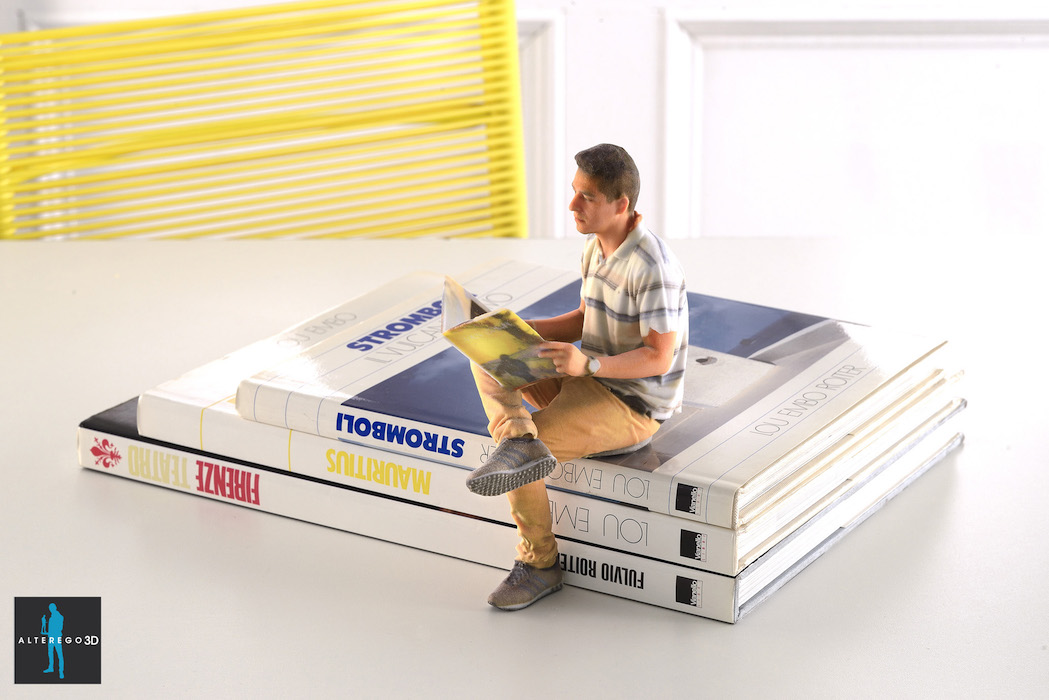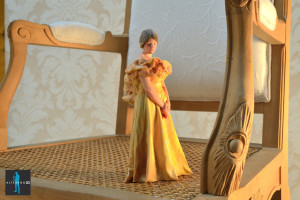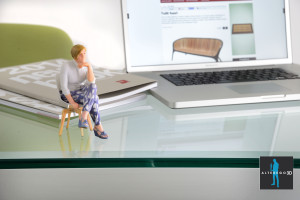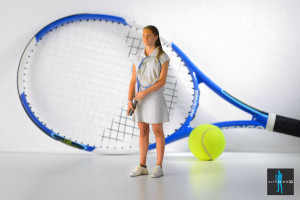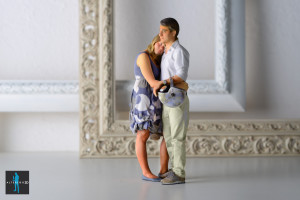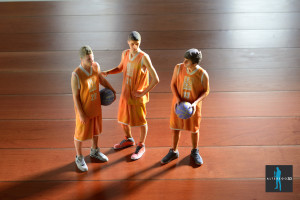Nel Cinquecento c’era Michelangelo. Nell’Ottocento è arrivata la fotografia. Oggi c’è il 3D. La nostra immagine, la riproduzione fedele di noi stessi si sta evolvendo fino a raggiungere risultati impensabili, grazie alle nuove tecnologie che hanno fornito sistemi sempre più innovativi. Paolo Polidori e i suoi soci hanno dato vita a un progetto nuovo, Alterego 3D, che grazie a scanner e stampanti 3D sempre più sofisticati consente l‘acquisizione dell’immagine e la sua fedele riproduzione.
“Sono sempre stato interessato a tutto ciò che è nuovo nel mercato – racconta Paolo – e il 3D mi ha sempre affascinato, è una vera rivoluzione industriale che toccherà vari settori. Mi chiedevo perché non si potesse utilizzare per creare un sogno, che fosse in primis il mio personale: quello di potersi vedere dall’esterno, avere una percezione di come ci si presenta al mondo, rispetto allo specchio che dà un’immagine falsata e bidimensionale. Il 3D equivale a fermare il tempo e quindi mi consente, ad esempio, di riavere davanti mia figlia quando era piccola: è l’evoluzione nel tempo della fotografia, del ritratto. Il nostro futuro è proprio il 3D o l’ologramma.”
Ma quindi perché pensare di posare e di farsi immortalare in maniera così precisa? “Le dinamiche sono totalmente diverse tra la fotografia e il 3D statuina: la fotografia intanto viene archiviata, non è sempre presente, mentre invece chi compra una statuina la tiene sempre in vista. Ma quello che davvero cambia è che di fotografie so che me ne farò tante, quindi non penso a come voglio essere rappresentato; quando faccio la statuita devo pensare a come rappresentarmi, perché si vede una parte di intimità che nella fotografia non c’è più. Quando vedi la statuina vedi parte della tua personalità: la profondità del 3D, la postura e la posa raccontato qualcosa che la fotografia non fa.”
Certo pensare di vedermi esposta su una mensola o su un tavolo, pensare che tutti possono fermarsi a osservarmi, tirarmi su, prendermi in mano, accarezzarmi, mi fa un certo effetto. “Strano è di sicuro – conferma Paolo – perché non c’è ancora un’abitudine. Questo tipo rappresentazione è anche abbastanza intima perché non siamo abituati a vederci da fuori, abbiamo solo un’idea di come siamo. La statua te lo ricorda e questo provoca un effetto strano nel senso di insolito. Per qualcuno è positivo, per qualcuno è inquietante. Di sicuro chi sceglie questa rappresentazione è chi ha il piacere di vedersi, di conoscersi, di mostrare se stesso a un altro e di mostrare che prima di tutti ha sfruttato questa capacità.”
A questo punto qualcuno si immagina già il pallone gonfiato o la vamp di turno che tutti imbellettati si dirigono verso lo scanner per farsi riprodurre. Beh, non va proprio in questo modo: “La clientela è molto trasversale. All’inizio prevedevamo che si sarebbero presentati un 60% di donne e un 40% di uomni, invece è stato proprio il contrario! Inoltre c’è una grande percentuale di bambini: i genitori vogliono ricordarli come sono adesso e far ricordare ai bambini stessi, che non ne hanno memoria, com’erano.”
Ma parlando di tecnologia vera e propria, come si acquisiscono le immagini? “Partendo dall’assunto che il nostro scopo è riprodurre il reale, la persona entra in un set di luci dove si trova una pedana girevole e un sistema di scanner registra l’immagine riportando i colori reali. Vengono quindi acquisiti i dati che sono mandati al centro di produzione, dove dei tecnici lavorano sulle immagini per riprodurre un poligono della persona. Dopo di che questo poligono viene mandato al reparto stampa e inserito in una stampante molto grande che utilizza delle polveri che hanno la possibilità di stampare con una precisione di 0,08 mm, ma anche di stampare già a colori e sfumature, per 36mila colori. In questo modo sono presenti tutte le tonalità, non c’è una post produzione che colora a mano. Il prodotto finito potrebbe essere definito una pietra leggera, ossia una pietra con peso specifico minore.” Solo esseri umani per il momento, ma in futuro stanno già pensando di spingersi fino alla riproduzione di animali, molto difficile perché sono sempre in movimento. A febbraio partiranno già dei progetti che prevedono la scannerizzazione di oggetti per la prototipazione, sia nel mondo fashion, dell’architettura e della meccanica, in quanto saranno in grado di stampare in gomma, metallo, ferro, acciaio, alluminio e plastiche dure.
Come ogni cosa che impiega tecnologia ad alti livelli chiaramente la riproduzione della statuina non è del tutto economica. Anche se, la possibilità di scegliere tra diverse dimensioni, consente comunque di avvicinarsi a un prezzo abbordabile: “Il riscontro del pubblico è stato molto alto contando che siamo in una categoria assolutamente nuova e il 98% della popolazione non sa nemmeno che è possibile avere una statua di se stessi. Il cliente all’inizio cerca di immaginare come potrebbe essere, e poi torna per farsi fare una statuina, di se stesso, di altri e ci sono capitati anche board aziendali. Il tipo di clientela è vario, troviamo fasce trasversali: dall’operaio, all’impiegato e anche il giovane, l’accesso è piuttosto possibile.”
A proposito di giovani, The WalkMan Magazine strizza l’occhio a tutti i ragazzi che con coraggio e ambizione stanno cercando di dar vita ai propri sogni, e perché no, investendo anche nelle nuove tecnologie. E Paolo ha un consiglio per tutti coloro che voglio intraprendere la sua stessa strada: “Se è vero che la maggior parte dei giovani non dispone di molti finanziamenti il consiglio è di aggregarsi a un franchisor. Il secondo consiglio è quello di cercare tra i finanziamenti pubblici dedicati ai giovani e alle nuove tecnologie, sia europei che regionali, che possono aiutare nella creazione di una start up. Perché parlo di franchising? Perché è un investimento alto, le strutture, i software, le stampati, gli scanner hanno un costo elevato, bisogna investire almeno 200mila euro. Chi vende questi macchinari non ha la competenza totale per lo sviluppo del processo, perché non sono stati inventati per la riproduzione di statuette; noi stessi abbiamo impiegato sei mesi per ottenere con continuità un risultato. Servono soldi e persone che lo sappiano fare, personale specializzato da formare perché non esiste.”
Un salto nel vuoto quello dei tre imprenditori che hanno dato vita ad Alterego 3D. Un salto che ha dato un risultato davvero alto. Una spinta verso un mondo dove la tecnologia la farà sempre più da padrone, grazie a persone che hanno deciso di investire in un settore ancora poco conosciuto dalla grande maggioranza della popolazione.
[divider]ENGLISH VERSION[/divider]
In the 16th century there was Michelangelo. In the 19th century photography was born. Today there is 3D. Our image, the faithful photographic reproduction of ourselves, is evolving and reaching inconceivable results thanks to new technologies, which have supplied increasingly innovative systems. Paolo Polidori and his partners have brought to life a new project, Alterego 3D, which, through sophisticated scanners and 3D printers, allows to acquire an image and then reproduce it faithfully.
“I’ve always been interested in everything new in the market” – Paolo says – “and 3D has always fascinated me, it is a real industrial revolution, that will involve different branches. I asked myself why it couldn’t be used to realize a dream, first of all, a dream of mine: that of being able to see yourself from the outside, of having a perception of how you appear to the world, which is different from your falsified and two-dimensional image in the mirror. With 3D you can stop time; for instance, it allows me to have again in front of me my daughter when she was a child: 3D is the evolution of photography, of portrait. 3D or holograms are our future.”
So, why we should think about posing and being immortalized in such an accurate way? “The dynamics of a photo and those of a 3D little statue are completely different: in fact, a photo is archived, it can’t be always on hand, while who purchases a statue will be able to look at it at any moment. But what really changes is the fact that I know I will take many photos of myself, so I don’t think much about how I want to be represented in each of them; when I make a statue of myself, I have to think about how I want to represent myself, because an intimate part of me, which can’t be found in a photo anymore, will be shown. When you look at the statue, you see a part of your personality: the depth of 3D and the pose tell something that photography does not.”
Surely, it’s rather odd to picture myself exposed on a shelf or on a table, to think that everyone can stop and look at me, pick me up, take me and caress me. “It is weird, for sure” – Paolo agrees – “because it isn’t a habit yet. This kind of representation is also a quite intimate one, because we are not used to see ourselves from the outside, we just have an idea of how we look. The statue reminds you that, and this causes a strange, actually unusual, feeling. To some it’s a good thing, to others it’s just disturbing. Certainly, if you choose this kind of representation, it means that you are pleased to see yourself, to get to know yourself, to show yourself to another and to show that you have chosen this particular way to represent yourself before anyone else has.”.
At this point, some of you are probably picturing some big-headed guy or an overdressed femme fatale walking towards the scanner, showing off, to be immortalized. Well, that’s not exactly what happens: “Our clientele is rather wide. Initially we had expected that 60% of the clientele would have been women and 40% would have been men, but it’s just the reverse! Besides, a high percentage of our clientele is made up by children: their parents want to remember them just the way they look now and show them how they were, since they won’t be able to remember it when they’re adults.”
But speaking of out-and-out technology, how do you acquire images? “I’ll start by saying that our aim is that of reproducing reality, a client enters the shooting set, where there are lights, a rotating platform and a scanner system which registers his or her image with real colors. Then, data are acquired and sent to the production centre, where technicians work on the images to create a polygon that reproduces the subject. After that, this polygon is sent to the printing department and inserted in a big printer which uses special powders to print with a precision of 0,08 mm and which immediately prints in color and shades, 36 thousand colors in all. This way all tones are used, in fact, there isn’t a hand painting post-production. The final product could be defined as ‘light stone’, in other words a stone which is characterized by a lesser specific weight”. For now, human beings are the only subjects reproduced by this innovative representation system, but they are thinking about reproducing animals as well, which is quite difficult because they move continuously. In February projects involving objects scanning to create a prototype, both for fashion and the branches of architecture and mechanics, will be started. In fact, they will soon be able to print on rubber, metal, iron, steel, aluminum and hard plastic.
Clearly, as for any other process that employs high-level technology, the creation of the statues is not completely cheap. Although the possibility of choosing the size that you prefer allows you to purchase the statue at an affordable price: “Considering that this is a definitely new category and the fact that 98% of population doesn’t even know that it is possible to have a statue which represents yourself, the response from the public has been very good. At first a client tries to imagine how it could be, and then he or she comes back to have a statue made for himself or herself, or for others. We’ve also dealt with business boards. We have heterogeneous clients, such as: workmen, employees and young people. It is quite an accessible service.”
Speaking of young people, The WalkMan Magazine encourages all the ambitious youngsters who are bravely trying to bring their dreams to life, and who are – why not? – investing in new technologies. Paolo has some advice for everyone who wants to take up his same career: “If it’s true that the majority of young people can’t obtain funds, my piece of advice is to join a franchise. My second piece of advice is to find public funds for youngsters and new technologies, both European and regional, which can help young people to create a start-up business. Why am I talking about franchising? Because this is a high investment; structures, software and scanners are expensive, one needs to invest at least 200 thousand Euros in a project like this. The sellers of the machinery aren’t quite able to develop the process, because it wasn’t created to the purpose of reproducing the statues; we spent six months on our project before achieving encouraging results. Youngsters are going to need money and people who are able to do this, they’ll have to recruit a qualified staff because it doesn’t exist.”
The three businessmen who brought Alterego 3D to life took a leap into the unknown. A leap that has delivered a significant result. It gives a boost towards a world that is going to be conquered by technology, thanks to some who have decided to invest in a branch that isn’t much known yet by the majority of people.
Traduzione a cura di Gabriella Berardinucci

